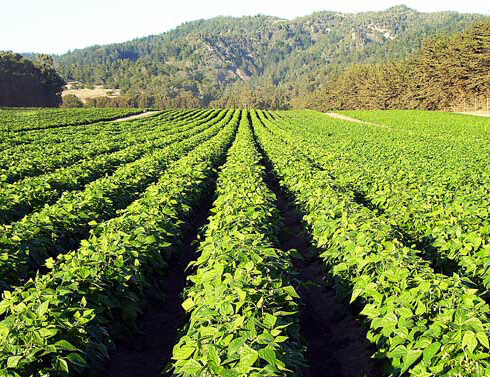
The ideal tool is designed for a common task, and facilitates the completion of that task with ease and comfort. This tool fits comfortably in your hand and balances with the rhythm of your action while you work. An ideal tool is designed to last for years of effort, and possibly get better with age. When you first hold this tool, it feels natural in your grip, however, with repeated use you develop proficiency with its use and master its strengths.
There may be no more perfect tool than a weeding hoe. Its five foot ash handle stands shoulder high, a length that offers the perfect angle when standing in a field and putting it to work. The handle is made of wood that is light but durable. It has a suppleness that let’s the tool flex to your pressure, but, it has the strength to offer necessary resistance. The wood of the shaft is smooth and rounded, at one end it widens in diameter slightly, so you grip knows that the end is near.
The surface of a new hoe’s handle comes smooth, sometimes varnished, or just oiled. It is ready to use, but, over the years, if it is kept out of the rain, the surface is infused with the oils of many hands, or leather gloves. It becomes as supple as silk to the touch.
A weeding hoe is not meant for breaking up clods of dirt or deeply aerating the soil, but rather for topping the greens that spring up from weed roots at surface level and stunting their growth, giving the row crop a chance to get ahead, and find their place in the sun. So, the weeding hoe has a thin blade, not the wide flattened trowel of the common gardening hoe. This blade is five or six inches across, and about the width of a 10” chef’s knife.
The blade is honed to an edge each day before being put to work. Put the neck of the tool into a vise, with the end of the handle on the floor, and the blade sits at the perfect angle to be sharpened with a fine metal file. As the blade metal is soft, just a few strokes at the appropriate angle brings it back to life. The business end is bright with new metal. The rest of the blade is blackened, with a patina of soil from past labors.
When you take a sharpened hoe into the field, its use could not be more obvious. When held in two hands at 45 degrees, the blade is almost parallel to the smooth surface of the garden soil. It is sharp enough to slice through any plant like a guillotine, beheading crabgrass, buckhorn, bindweed, Lamb’s quarter, and dandelion alike. Wielded carefully, the blade is short enough to cut close to the crop you aim to save, while not disturbing its progress.
Even the most careful gardener will occasionally decapitate a young cabbage or lettuce, however, this is where the practice brings mastery to the simple task. While it takes a moment to understand the use of this wonderful tool, years of practice will improve your speed and accuracy. There lies the satisfaction of simple labor.
While some choose meditation, and some prayer, I find there is no better place for quiet contemplation than walking backwards along a long garden row, hoe in hand, freeing young crop plants from their competition. There is no greater sense of accomplishment than looking back at a field, made of of 20 or 30 long rows, and seeing it transformed into a rich brown loamy surface, with only the regular interruption of evenly spaced crops.